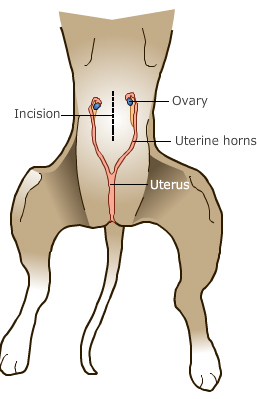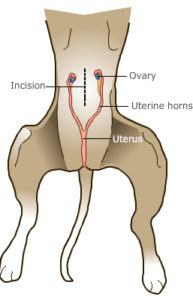
Ovary Sparing Spay (Hysterectomy)
Spay surgery (ovariohysterectomy – OHE) has been the accepted and recommended procedure for all female dogs when breeding is not the goal. This procedure involves surgical removal of both ovaries and the uterus. The benefits of this surgery are the elimination of: unwanted pregnancies, bloody discharge associated with the heat cycle, ovarian cancer, uterine infections (pyometra), and mammary cancer. 
Until recently, no alternative to a complete OHE was considered. However, with increased evidence that in addition to previously recognized sequelae to the OHE such as hormonal urinary incontinence, there is now evidence that large and giant breed dogs are more prone to certain cancers such as bone and lymphatic cancer. Also some dogs have a higher level of anxiety after OHE than those who are left intact.
The evidence that some dogs are at increased risk of developing life -threatening illness after removal of the ovaries has led to the acceptance of an alternative procedure. Instead of removing the ovaries and the uterus, the ovaries are left intact. Only the uterus is removed.
Dogs who retain their ovaries will continue to experience heat cycles. During the heat, the vulva will enlarge, but no discharge will occur. The dog will ‘act’ like she is in heat – prepared to accept a male for the breeding act. Some females change their behavior during this time, and rarely a female can become more aggressive.
These dogs will remain at risk for ovarian and mammary cancers. As they are still stimulated by reproductive hormones, they are at risk for development of an infection (stump pyometra) of any remaining uterine tissue. Throughout their dog’s life, a guardian must be prepared to inform their veterinarian if the dog has retained ovaries. If a stump pyometra is suspected, diagnostic testing will be required, as well as possible exploratory surgery to rule out or remove the infected tissue.
In order to minimize the chance of developing this type of infection, this surgical procedure is best performed when the pup is quite young – between 3-5 months of age. Because there is minimal fat around the ovaries at this age, it is easier to ensure removal of every millimeter of uterine tissue. As we are leaving the ovaries intact, there is no downside to doing this procedure before the dog is full grown, i.e. there is no impact on growth or maturation.
The surgical procedure for an OHE and an ovary sparing surgery are similar. An abdominal incision is required. The same complications are possible as for any other abdominal surgery. However, in order to perform an ovary sparing surgery, a much longer incision is required.
At your puppy visits, our doctors will discuss the best plan for your particular pet. As you can see, it is not a black and white issue. Some dogs will be better served with a full OHE, and others with an ovary sparing procedure. Don’t hesitate to ask for a consult if you have any questions.
